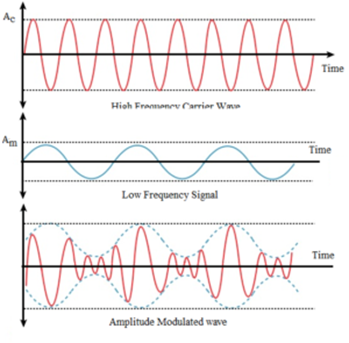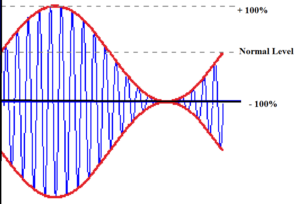Science > Physics > Communication > Amplitude Modulation
The first amplitude modulated signal was transmitted in 1901 by a Canadian engineer named Reginald Fessenden. He used a continuous spark transmission and placed a carbon microphone in the antenna lead. This transmission was very crude, signals were audible over a distance of a few hundred metres. The quality of the audio was not good. In amplitude modulation, angular frequency ω and the phase Φ are kept constant and the amplitude Ac of the carrier wave is varied in accordance with the modulating wave. When the amplitude of a high-frequency carrier wave is changed in accordance with the intensity of the signal, it is called amplitude modulation.
Amplitude modulation is done by a circuit called modulator. In amplitude modulation, the amplitude of the carrier is varied in accordance with the information signal. Here we explain the amplitude modulation process using a sinusoidal signal as the modulating signal.

We can see that during the positive cycle of low-frequency signal and the positive cycle of carrier wave the amplitude of carrier wave increased, while in the negative cycle it is decreased.
Features of Amplitude Modulated Wave:
- The amplitude of carrier wave changes according to the intensity of the signal.
- The variation in amplitude of a carrier wave is at the frequency of the signal fm.
- The frequency of amplitude modulated wave is the same as that of the carrier wave fc.
- The amplitude of amplitude modulated wave is not constant but it has a similar sinusoidal variation as that of the signal wave. Thus the amplitude-modulated wave is loaded with the information contained in the low-frequency signal message.
- As amplitude modulation is simple it is widely used.
Modulation Factor or Modulating Index:
The ratio of change of amplitude of the carrier wave to the amplitude of the normal carrier wave is called the modulation factor. It describes the depth of modulation i.e. the extent in the variation of the amplitude of carrier wave due to the signal.
The value of the modulation factor depends upon the amplitude of the carrier wave and the signal.
Importance of the Modulation Index:
- It is an indicator of the level of modulation.
- If there is too low a level of modulation then the amount of variation in carrier amplitude is small. Thus the audio signal being transmitted will not be very strong. Hence the modulation does not utilize the carrier efficiently.
- If there is a too high level of modulation then the carrier can become over modulated causing sidebands to extend out beyond the allowed bandwidth causing interference to other users. Hence there will be distortion during the reception.
Amplitude modulation with modulation factor 0.5 or 50%

Amplitude modulation with modulation factor 1 or 100%
When the modulation index reaches 1.0, i.e. a modulation depth of 100%, the carrier level falls to zero and rise to twice its non-modulated level.

Amplitude modulation with a modulation factor greater than 1 or greater than 100%
Any increase of the modulation index above 1.0, i.e. 100% modulation depth causes over-modulation.

The carrier experiences 180° phase reversals where the carrier level would try to go below the zero point. Due to this phase reversals, there is a rise in additional sidebands resulting from the phase reversals (phase modulation) that extend out, to infinity theoretically. This may cause serious interference to other users if not filtered.
Broadcast stations, take measures to ensure that the carries of their transmissions never become overmodulated. The transmitters incorporate limiters to prevent more than 100% modulation. They incorporate automatic audio gain controls to keep the audio levels near 100% modulation for most of the time.
Expression For Modulation Index:
The modulation index (μa) of an amplitude-modulated wave is defined as the ratio of the amplitude of the modulating signal (Em) to the amplitude of the carrier wave (Ec).
μa = (Em)/(Ec)
To avoid distortion Em < Ec
For modulated wave
μa = (Emax – Emmin)/(Emax + Emin)
If for AM wave the maximum amplitude is ‘a’ while the minimum amplitude is ‘b’
Emax = (Ec + Em) = a …………. (1)
Emin = (Ec – Em) = b …………. (2)
Solving equation (1) and (2) we get
Em = (a – b)/2 and Ec = (a + b)/2
μa = (Em)/(Ec) = (a – b)/(a + b)
Demodulation:
The AM signal received is passed through a demodulator to extract the information being carried by it. The process of separating or extracting the modulation from a signal is called demodulation or detection. Demodulation of AM signals can be done using simple circuits consisting of diodes.
Advantages Of Amplitude Modulation:
- It is simple to implement.
- Demodulation of AM signals can be done using simple circuits consisting of diodes.
- AM transmitters are less complex.
- AM receivers are very cheap as no specialized components are needed.
- AM waves can travel a longer distance.
- AM waves have low bandwidth
Disadvantages of Amplitude Modulation:
- An amplitude modulation signal is not efficient in terms of its power usage. Power wastage takes place in DSB-FC (Double Side Band – Full Carrier ) transmission.
- It is not efficient in terms of its use of bandwidth. It requires a bandwidth equal to twice that of the highest audio frequency. In amplitude modulation sidebands contain the signal. The power in sidebands is the only useful power. For 100 % modulation, the power carried by AM waves is 33.3 %. The power carried by the AM wave decreases with the decrease in the extent of modulation.
- AM detectors are sensitive to noise hence an amplitude modulation signal is prone to high levels of noise.
- Reproduction is not high fidelity. For high fidelity (stereo) transmission bandwidth should be 40000 Hz. To avoid interference the actual bandwidth used by AM transmission is 10000 Hz.
In spite of the disadvantages amplitude modulation is still in widespread use for broadcasting on the long, medium and short wave bands, some mobile or portable communications systems including some aircraft communications.
Applications of Amplitude Modulation:
Broadcast transmissions:
AM is still widely used for commercial broadcasting on the long, medium and short wave bands because the radio receivers capable of demodulating amplitude modulation are cheap and simple to manufacture. The atmospheric signals like lightening and man-made electrical signals affect this transmission.
Air-band radio:
VHF transmissions for many airborne applications still use AM. It is used for ground to air and ground to ground radio communications. e.g. television standard broadcasting, aids to navigation, telemetering, radar and, facsimile. etc.
Single sideband:
Amplitude modulation in the form of single sideband is still used for point to point HF (high frequency) radio links.
Quadrature amplitude modulation:
AM is widely used for the transmission of data in everything from short-range wireless links such as Wi-Fi to cellular telecommunications and much more. Quadrature amplitude modulation is formed by mixing two carriers that are out of phase by 90°.
Previous Topic: Modulation of Signal
Next Topic: Internet and Its Associated Technologies

One reply on “Amplitude Modulation”
Good reading and writing